Open and Closed Black Soldier Fly Systems Tradeoff Analysis
Abstract
:1. Introduction
2. Materials and Methods
2.1. Geographical Context
2.2. Co-Production
2.3. BSFL Production System
2.3.1. Organic Waste Bioconversion
2.3.2. Frass Composting
2.4. Life Cycle Assessment
2.4.1. Goal and Scope
2.4.2. System Boundaries
2.5. Life Cycle Inventory
2.5.1. BSF System Construction
2.5.2. Waste, Waste Collection and System Sizing
2.5.3. BSF, BSFL Production and Breeding
2.5.4. Assumptions
3. Results
3.1. Global Warming Potential
3.2. Land Use
4. Discussion
Sensitivity Analysis
5. Conclusions
Author Contributions
Funding
Institutional Review Board Statement
Informed Consent Statement
Data Availability Statement
Acknowledgments
Conflicts of Interest
Appendix A
| Material | Quantity | Unit | openLCA Entry | Unit | Assumptions | Reference | |
|---|---|---|---|---|---|---|---|
| Bioreactor Construction | |||||||
| Sand | 2 | tons | 2 | tons | 2–3 tons capacity truck used in hauling sand. 2 tons assumed usage because of leftover | ||
| Bricks | 130 | pieces | 707.629 | kg | 30 cm × 14 cm × 9 cm. 1440 kg/m3 density for 5.4433 kg per brick. | ||
| Gravel | 270 | kg | 270 | kg | 15 bags of gravel @ 18 kg/bag | ||
| Cement | 215 | kg | 215 | kg | 5 bags of cement @ 43 kg/bag | ||
| Wire mesh | 7 | pieces | 39.56 | kg | Welded Wire Mesh—1 kg/m2 (Ref No. 100. 200 × 200 mm, 4 mm wire size) 1 × 2 m wire sheets assumed (8 in total with metal roof). Total wire mesh weight for bioreactor installation was 39.56 kg ((4.3 length × 2.3 width/1 × 2 mesh size) × 8 mesh count) | https://www.weldedwiresupplier.com/products/reinforcingbarmesh.html (accessed on 7 December 2023) | |
| Hardwood beams (2 × 2″) | 4 | pieces | 0.03794 | m3 | 2 × 4 × 12 kiln-dried wood weighing 7.2 kg (from reference) • volumetric estimation: 0.335 ft3 (0.167 ft × 0.167 ft × 12 ft), i.e., 0.009486 m3 | https://www.engineeringtoolbox.com/green-kiln-dried-pressure-treated-lumber-weights-d_1860.html (accessed on 7 December 2023) | |
| Hardwood beams (1 × 6″) | 4 | pieces | 0.0564 | m3 | 2 × 4 × 10 kiln-dried wood weighing 5.85 kg • volumetric estimation: 0.498 ft3 (0.083′ × 0.5′ × 12′), i.e., 0.0141 m3 | https://www.engineeringtoolbox.com/green-kiln-dried-pressure-treated-lumber-weights-d_1860.html (accessed on 7 December 2023) | |
| Nails (2″) | 1 | kg | 1 | 0 | kg | Added to roofing sheet weight | |
| Nails (4″) | 0.5 | kg | 0.5 | 0 | kg | Added to roofing sheet weight | |
| Metal Roofing | |||||||
| Square pipe (1 × 1″) | 12 | pieces | 29.5884 | kg | 5.436 lbs (0.453 lbs/foot weight for 1 × 1″ for 12 ft) i.e., 2.4657 kg per piece | https://www.industrialtube.com/square-structural-tubing/ (accessed on 7 December 2023) | |
| Hinge (3″) | 12 | pieces | 0 | kg | Not available in ecoinvent; therefore, ignored | ||
| Paint thinner | 2 | liters | 1.554 | kg | 6.49 lbs (2.94 kg) for 1 gallon (3.785 L). All paint and thinners entered as “Solvent for paint” in openLCA | https://www.amazon.com/Klean-Strip-GKPT94400-Paint-Thinner-1-Gallon/dp/B000GF49M4 (accessed on 7 December 2023) | |
| Red oxide | 2 | liters | 0 | Not available in ecoinvent; therefore, ignored | |||
| Black gloss | 2 | liters | 0 | Not available in ecoinvent; therefore, ignored | |||
| Tin nails | 1 | kg | 1 | 0 | kg | Added to roofing sheet weight | |
| Wire mesh | 1 | piece | 4.945 | 0 | kg | Added to bioreactor construction wire mesh | |
| Aluminum roofing sheets (10 ft 30-gauge) | 6 | pieces | 21.78 | 24.28 | kg | 3.63 kg/sheet (8 lbs—8 ft 31-guage used). Weight of nails included here as openLCA entry | https://www.homedepot.com/p/8-ft-Corrugated-Galvanized-Steel-31-Gauge-Roof-Panel-13513/202092961 (accessed on 7 December 2023) |
| Painting | |||||||
| Paint (gray) | 10 | liters | 0 | Not available in ecoinvent; therefore, ignored | |||
| Paint (white) | 1 | litres | 0 | Not available in ecoinvent; therefore, ignored | |||
| Miscellaneous | |||||||
| Chicken wire (3 m) | 1 | piece | 0 | Not available in ecoinvent; therefore, ignored | |||
| PVC Pipes and elbows | 2 | pieces | 0 | Not available in ecoinvent; therefore, ignored | |||
| Bucket (20 L) | 2 | pieces | 0 | Not available in ecoinvent; therefore, ignored | |||
| Metal net | 1 | piece | 0 | 1 m | |||
| Paint brush | 2 | pieces | 0 | Not available in ecoinvent; therefore, ignored | |||
| Roller | 1 | piece | 0 | Not available in ecoinvent; therefore, ignored | |||
| Drying Unit | |||||||
| Metal Pipes (2 × 2″) | 8 | pieces | 7.076 | kg | Square pipe—7.076 kg (15.6 lbs @1.3 lbs/ft for 2″ × 2″ at 12 ft) | https://www.industrialtube.com/square-structural-tubing/ (accessed on 7 December 2023) | |
| Aluminum roofing sheets | 8 | pieces | 18.15 | kg | 3.63 kg/sheet (8 lbs—8 ft 31-guage used). Accounting error suspected; five pieces used | https://www.homedepot.com/p/8-ft-Corrugated-Galvanized-Steel-31-Gauge-Roof-Panel-13513/202092961 (accessed on 7 December 2023) | |
| Wire mesh | 2 | pieces | 4.945 | kg | 4.945 kg (Ref No. 100. 200 × 200 mm, 4 mm wire size) | https://www.weldedwiresupplier.com/products/reinforcingbarmesh.html (accessed on 7 December 2023) | |
| Wood | 1 | piece | 0.0141 | m3 | One piece of 1 × 6″ wood assumed for wooden trays—0.0141 m3 | ||
| Labels | Sum of Waste (kg) | Larvae Harvested (kg) | Frass Harvested (kg) | Frass Dried (kg) | Count of Larvae Application |
|---|---|---|---|---|---|
| January | 655 | 7.76836 | 60 | 33 | 15 |
| November | 632 | 0.575 | 34.75 | 10 | 18 |
| December | 616 | 2.75994 | 143.25 | 20.5 | 14 |
| Monthly Average Waste | 634.33 | ||||
| STD | 19.60 | ||||
| Daily Average Waste | 21.14 | ||||
| Open System Sizing | |||||
| Data-based Unit size (area) | (4.96 × 2.93) + (0.5 × 1.2) | 15.13 | m2 (bioreactor and drying unit) | ||
| Data-based Unit size (volume) | 15.1328 × 0.56 | 8.47 | m3 (same height assumed) | ||
| Calculated Unit area (@ 1 ton waste/day) | (1000 × 15.1328) ÷ 21.14 | 715.69 | m2 | ||
| Calculated Unit volume (@ 1 ton waste/day) | (1000 × 8.47) ÷ 21.14 | 400.78 | m3 | ||
| Number of open systems needed to treat 1 ton waste/day | 400.78 ÷ 8.47 | 47 | |||
| Closed System Sizing | |||||
| 187 m2 @ 1 ton/day (based on [13] Figure 5) | 187 × 2.74 | 512.4 | m3 (assuming 9 ft i.e., 2.74 m ceiling) | ||
| Comparing Sizes | |||||
| # Closed to Open system for 1 ton/day | 187 ÷ 715.69 | 0.3 | area based | ||
| # Closed to Open system for 1 ton/day | 512.38 ÷ 400.78 | 1.3 | volume based | ||
| By Main Constituent | Units Needed for 1 ton/day 15 Years | Units Needed for 1 ton/day 25 Years | Weight per Unit (kg) | Total Weight (kg) 15 Years | Total Weight (kg) 25 Years | Reference (Literature) | Reference (Manufacturers) | |
|---|---|---|---|---|---|---|---|---|
| Plastic | 1388.22 | 2313.71 | Plastic injection molding assumed | |||||
| Conversion crates | 800 | 1333.33 | 1.60 | 1280.00 | 2133.33 | [13] | Vegcrates | Ventilated plastic crates for shrimp |
| Pupation crates | 23 | 38.33 | 1.60 | 36.80 | 61.33 | [13] | Vegcrates | Ventilated plastic crates for shrimp |
| Egg media | 50 | 83.33 | 0.05 | 2.41 | 4.02 | [13] | Amazon | Biochemical Ball Filter Media |
| Hatchling crate | 11 | 18.33 | 1.60 | 17.60 | 29.33 | [13] | Vegcrates | Ventilated plastic crates for shrimp |
| Egg media | 160 | 266.67 | 0.05 | 7.71 | 12.85 | [13] | Amazon | Biochemical Ball Filter Media |
| Nursery Larvero | 17 | 28.33 | 1.60 | 27.20 | 45.33 | [13] | Vegcrates | Ventilated plastic crates for shrimp |
| Collection container | 17 | 28.33 | 0.95 | 16.15 | 26.92 | Uline | 20 liter bucket assumed | |
| Egg media holder | 32 | 53.33 | 0.01 | 0.35 | 0.59 | Amazon | Aquarium Nylon Bag mesh | |
| Metal | 284.00 | 473.33 | Chromium steel production | |||||
| Ventilation frames | 120 | 200.00 | 1.20 | 144.00 | 240.00 | Amazon | 32 × 22.9 × 15.4 cm assumed | |
| Pallet trolley | 1 | 1.67 | 10.60 | 10.60 | 17.67 | Amazon | 177.8 cm × 74.98 × 34.98 cm assumed | |
| Shredder | 1 | 1.67 | 10.60 | 10.60 | 17.67 | Amazon | 177.8 cm × 74.98 × 34.98 cm assumed | |
| Dark cage frame | 1 | 1.67 | 8.92 | 8.92 | 14.87 | Amazon | 59.99 × 35 × 150 cm assumed | |
| Love cage frame | 2 | 3.33 | 8.92 | 17.84 | 29.73 | Amazon | 59.99 × 35 × 150 cm assumed | |
| Hatching frame | 2 | 3.33 | 8.92 | 17.84 | 29.73 | Amazon | 59.99 × 35 × 150 cm assumed | |
| Larvero frame | 6 | 10.00 | 10.60 | 63.60 | 106.00 | Amazon | 177.8 cm × 74.98 × 34.98 cm assumed | |
| Mobile fly harvester | 1 | 1.67 | 10.60 | 10.60 | 17.67 | Amazon | 177.8 cm × 74.98 × 34.98 cm assumed | |
| Fabric | 8.15 | 13.58 | ||||||
| Love cage | 5 | 8.33 | 1.36 | 6.79 | 11.32 | Alibaba | 75 × 75 × 115 cm assumed | |
| Dark cage | 1 | 1.67 | 1.36 | 1.36 | 2.26 | Alibaba | 75 × 75 × 115 cm assumed | |
| Wood | 399.56 | 665.93 | ||||||
| Pallets | 20 | 33.33 | 18.64 | 372.80 | 621.33 | Global Industrial | 101.6 × 121.92 cm assumed | |
| Working table | 2 | 3.33 | 8.92 | 17.84 | 29.73 | Amazon | 59.99 × 35 × 150 cm assumed | |
| Working table | 1 | 1.67 | 8.92 | 8.92 | 14.87 | Amazon | 59.99 × 35 × 150 cm assumed |
References
- Quilliam, R.S.; Nuku-Adeku, C.; Maquart, P.; Little, D.; Newton, R.; Murray, F. Integrating Insect Frass Biofertilisers into Sustainable Peri-urban Agro-food Systems. J. Insects Food Feed 2020, 6, 315–322. [Google Scholar] [CrossRef]
- Čičková, H.; Newton, G.L.; Lacy, R.C.; Kozánek, M. The use of fly larvae for organic waste treatment. Waste Manag. 2015, 35, 68–80. [Google Scholar] [CrossRef]
- Destoumieux-Garzón, D.; Mavingui, P.; Boetsch, G.; Boissier, J.; Darriet, F.; Duboz, P.; Fritsch, C.; Giraudoux, P.; Le Roux, F.; Morand, S.; et al. The One Health Concept: 10 Years Old and a Long Road Ahead. Front. Vet. Sci. 2018, 5, 14. [Google Scholar] [CrossRef]
- Deepak Mathew, D.K.; Kannan, A.; Joseph, M.; Suraj, P.T.; Sunil; Shyama, K.; Berin, P. Bioconversion of Food Waste by Black Soldier Fly Larvae Under Natural Settings. J. Indian Vet. Assoc. 2021, 19, 73. [Google Scholar] [CrossRef]
- Cappellozza, S.; Leonardi, M.G.; Savoldelli, S.; Carminati, D.; Rizzolo, A.; Cortellino, G.; Terova, G.; Moretto, E.; Badaile, A.; Concheri, G.; et al. A First Attempt to Produce Proteins from Insects by Means of a Circular Economy. Animals 2019, 9, 278. [Google Scholar] [CrossRef]
- Verner, D.; Roos, N.; Halloran, A.; Surabian, G.; Tebaldi, E.; Ashwill, M.; Vellani, S.; Konishi, Y. Mainstreaming Insect Farming. In Insect and Hydroponic Farming in Africa: The New Circular Food Economy; Agriculture and Food Series; World Bank Publications: Minneapolis, MN, USA, 2021; pp. 115–191. ISBN 978-1-4648-1766-3. [Google Scholar]
- Caruso, D.; Devic, E.; Subamia, I.W.; Talamond, P.; Baras, E. Technical Handbook of Domestication and Production of Diptera Black Soldier Fly (BSF), Hermetia illucens, Stratiomyidae; IRD Edition: Marseille, France, 2013. [Google Scholar]
- Cortes Ortiz, J.A.; Ruiz, A.T.; Morales-Ramos, J.A.; Thomas, M.; Rojas, M.G.; Tomberlin, J.K.; Yi, L.; Han, R.; Giroud, L.; Jullien, R.L. Insect Mass Production Technologies. In Insects as Sustainable Food Ingredients; Dossey, A.T., Morales-Ramos, J.A., Rojas, M.G., Eds.; Academic Press: San Diego, CA, USA, 2016; pp. 153–201. ISBN 978-0-12-802856-8. [Google Scholar]
- Kenis, M.; Bouwassi, B.; Boafo, H.; Devic, E.; Han, R.; Koko, G.; Koné, N.; Maciel-Vergara, G.; Nacambo, S.; Pomalegni, S.C.B.; et al. Small-Scale Fly Larvae Production for Animal Feed. In Edible Insects in Sustainable Food Systems; Halloran, A., Flore, R., Vantomme, P., Roos, N., Eds.; Springer International Publishing: Cham, Switzerland, 2018; pp. 239–261. ISBN 978-3-319-74011-9. [Google Scholar]
- Pastor, B.; Velasquez, Y.; Gobbi, P.; Rojo, S. Conversion of organic wastes into fly larval biomass: Bottlenecks and challenges. J. Insects Food Feed 2015, 1, 179–193. [Google Scholar] [CrossRef]
- Diener, S.; Lalander, C.; Zurbruegg, C.; Vinnerås, B. Opportunities And Constraints For Medium-Scale Organic Waste Treatment with Fly Larvae Composting. In Proceedings of the Sardinia 2015, Fifteenth International Waste Management and Landfill Symposium, Cagliari, Italy, 5–9 October 2015; CISA Publisher: Cagliari, Italy, 2015. [Google Scholar]
- Surendra, K.C.; Tomberlin, J.K.; van Huis, A.; Cammack, J.A.; Heckmann, L.-H.L.; Khanal, S.K. Rethinking organic wastes bioconversion: Evaluating the potential of the black soldier fly (Hermetia illucens (L.)) (Diptera: Stratiomyidae) (BSF). Waste Manag. 2020, 117, 58–80. [Google Scholar] [CrossRef]
- da Silva, G.D.P.; Hesselberg, T. A Review of the Use of Black Soldier Fly Larvae, Hermetia illucens (Diptera: Stratiomyidae), to Compost Organic Waste in Tropical Regions. Neotrop. Entomol. 2020, 49, 151–162. [Google Scholar] [CrossRef]
- Dortmans, B.; Diener, S.; Verstappen, B.; Zurbrügg, C. Black Soldier Fly Biowaste Processing. A Step-by-Step Guide; Swiss Federal Institute of Aquatic Science and Technology: Dübendorf, Switzerland, 2017. [Google Scholar]
- Zabaleta, I.; Mertenat, A.; Scholten, L.; Zurbrügg, C. Selecting Organic Waste Treatment Technologies; Swiss Federal Institute of Aquatic Science and Technology, Eawag: Dübendorf, Switzerland, 2020. [Google Scholar]
- Sheppard, C.D.; Newton, L.G.; Thompson, S.A.; Savage, S. A value added manure management system using the black soldier fly. Bioresour. Technol. 1994, 50, 275–279. [Google Scholar] [CrossRef]
- Koné, N.; Sylla, M.; Nacambo, S.; Kenis, M. Production of house fly larvae for animal feed through natural oviposition. J. Insects Food Feed 2017, 3, 177–186. [Google Scholar] [CrossRef]
- Diener, S.; Zurbrügg, C.; Tockner, K. Conversion of organic material by black soldier fly larvae: Establishing optimal feeding rates. Waste Manag. Res. 2009, 27, 603–610. [Google Scholar] [CrossRef]
- Nyakeri, E.M.; Ogola, H.J.; Ayieko, M.A.; Amimo, F.A. An Open System for Farming Black Soldier Fly Larvae as a Source of Proteins for Smallscale Poultry and Fish Production. J. Insects Food Feed 2017, 3, 51–56. [Google Scholar] [CrossRef]
- Hem, S.; Toure, S.; Sagbla, C.; Legendre, M. Bioconversion of palm kernel meal for aquaculture: Experiences from the forest region (Republic of Guinea). Afr. J. Biotechnol. 2008, 7, 1192–1198. [Google Scholar]
- Sankara, F.; Sankara, F.; Pousga, S.; Coulibaly, K.; Nacoulma, J.P.; Ilboudo, Z.; Ouédraogo, I.; Somda, I.; Kenis, M. Optimization of Production Methods for Black Soldier Fly Larvae (Hermetia illucens L.) in Burkina Faso. Insects 2023, 14, 776. [Google Scholar] [CrossRef]
- Karkour, S.; Rachid, S.; Maaoui, M.; Lin, C.-C.; Itsubo, N. Status of Life Cycle Assessment (LCA) in Africa. Environments 2021, 8, 10. [Google Scholar] [CrossRef]
- Roffeis, M.; Almeida, J.; Wakefield, M.E.; Valada, T.R.A.; Devic, E.; Koné, N.; Kenis, M.; Nacambo, S.; Fitches, E.C.; Koko, G.K.D.; et al. Life Cycle Inventory Analysis of Prospective Insect Based Feed Production in West Africa. Sustainability 2017, 9, 1697. [Google Scholar] [CrossRef]
- Roffeis, M.; Fitches, E.C.; Wakefield, M.E.; Almeida, J.; Alves Valada, T.R.; Devic, E.; Koné, N.; Kenis, M.; Nacambo, S.; Koko, G.K.D.; et al. Ex-ante life cycle impact assessment of insect based feed production in West Africa. Agric. Syst. 2020, 178, 102710. [Google Scholar] [CrossRef]
- Realpe, A.; Wallace, L.M. What Is Co-Production? Coventry University: London, UK, 2010; p. 11. [Google Scholar]
- Pestoff, V. Collective Action and the Sustainability of Co-Production. Public Manag. Rev. 2014, 16, 383–401. [Google Scholar] [CrossRef]
- Chineme, A.; Shumo, M.; Assefa, G.; Herremans, I.; Wylant, B. Solid Waste Management—Recent Advances, New Trends and Applications. In Simple Is Better When Appropriate: An Innovative Accessible Approach to Biowaste Treatment Using Wild Black Soldier Fly; IntechOpen: London, UK, 2023; ISBN 978-1-83769-810-3. [Google Scholar]
- Ites, S.; Smetana, S.; Toepfl, S.; Heinz, V. Modularity of insect production and processing as a path to efficient and sustainable food waste treatment. J. Clean. Prod. 2020, 248, 119248. [Google Scholar] [CrossRef]
- Mertenat, A.; Diener, S.; Zurbrügg, C. Black Soldier Fly biowaste treatment—Assessment of global warming potential. Waste Manag. 2019, 84, 173–181. [Google Scholar] [CrossRef] [PubMed]
- Salomone, R.; Saija, G.; Mondello, G.; Giannetto, A.; Fasulo, S.; Savastano, D. Environmental impact of food waste bioconversion by insects: Application of Life Cycle Assessment to process using Hermetia illucens. J. Clean. Prod. 2017, 140, 890–905. [Google Scholar] [CrossRef]
- Smetana, S.; Spykman, R.; Heinz, V. Environmental aspects of insect mass production. J. Insects Food Feed 2020, 7, 553–571. [Google Scholar] [CrossRef]
- Komakech, A.J.; Sundberg, C.; Jönsson, H.; Vinnerås, B. Life cycle assessment of biodegradable waste treatment systems for sub-Saharan African cities. Resour. Conserv. Recycl. 2015, 99, 100–110. [Google Scholar] [CrossRef]
- ISO 14040:2006; International Organization for Standardization Environmental Management: Life Cycle Assessment; Principles and Framework. ISO: Geneva, Switzerland, 2006.
- ISO 14044:2006; International Organization for Standardization Environmental Management: Life Cycle Assessment; Requirements and Guidelines. ISO: Geneva, Switzerland, 2006.
- Ddiba, D.; Andersson, K.; Rosemarin, A.; Schulte-Herbrüggen, H.; Dickin, S. The circular economy potential of urban organic waste streams in low- and middle-income countries. Environ. Dev. Sustain. 2022, 24, 1116–1144. [Google Scholar] [CrossRef]
- Gold, M.; Ireri, D.; Zurbrügg, C.; Fowles, T.; Mathys, A. Efficient and safe substrates for black soldier fly biowaste treatment along circular economy principles. Detritus 2021, 16, 31–40. [Google Scholar] [CrossRef]
- Kamau, J.M.; Mbui, D.N.; Mwaniki, J.M.; Mwaura, F.B. Proximate Analysis of Fruits and Vegetables Wastes from Nairobi County, Kenya. Res. J. Food Sci. Nutr. 2020, 5, 9–15. [Google Scholar] [CrossRef]
- Gougbedji, A.; Agbohessou, P.; Lalèyè, P.A.; Francis, F.; Caparros Megido, R. Technical basis for the small-scale production of black soldier fly, Hermetia illucens (L. 1758), meal as fish feed in Benin. J. Agric. Food Res. 2021, 4, 100153. [Google Scholar] [CrossRef]
- Guo, H.; Jiang, C.; Zhang, Z.; Lu, W.; Wang, H. Material flow analysis and life cycle assessment of food waste bioconversion by black soldier fly larvae (Hermetia illucens L.). Sci. Total Environ. 2021, 750, 141656. [Google Scholar] [CrossRef] [PubMed]
- Liu, Z.; Minor, M.; Morel, P.C.H.; Najar-Rodriguez, A.J. Bioconversion of Three Organic Wastes by Black Soldier Fly (Diptera: Stratiomyidae) Larvae. Environ. Entomol. 2018, 47, 1609–1617. [Google Scholar] [CrossRef]
- Ojha, S.; Bußler, S.; Schlüter, O.K. Food waste valorisation and circular economy concepts in insect production and processing. Waste Manag. 2020, 118, 600–609. [Google Scholar] [CrossRef]
- US Department of Agriculture Soybean Explorer. Available online: https://ipad.fas.usda.gov/cropexplorer/cropview/commodityView.aspx?cropid=2222000 (accessed on 16 October 2023).
- Nugroho, R.A.; Rofiq, M.N.; Santoso, A.D.; Yanuar, A.I.; Hanifa, R.; Nadirah, N. Bioconversion of biowaste by black soldier fly larvae (Hermetia illucens L.) for dried larvae production: A life cycle assessment and environmental impact analysis. F1000Research 2023, 12, 814. [Google Scholar] [CrossRef]
- Beyers, M.; Coudron, C.; Ravi, R.; Meers, E.; Bruun, S. Black soldier fly larvae as an alternative feed source and agro-waste disposal route—A life cycle perspective. Resour. Conserv. Recycl. 2023, 192, 106917. [Google Scholar] [CrossRef]
- EAWAG Aquatic Research Simplified Excel Calculator for a BSF Facility 2023. Available online: https://www.eawag.ch/en/department/sandec/projects/mswm/practical-knowhow-on-black-soldier-fly-bsf-biowaste-processing/ (accessed on 7 December 2023).

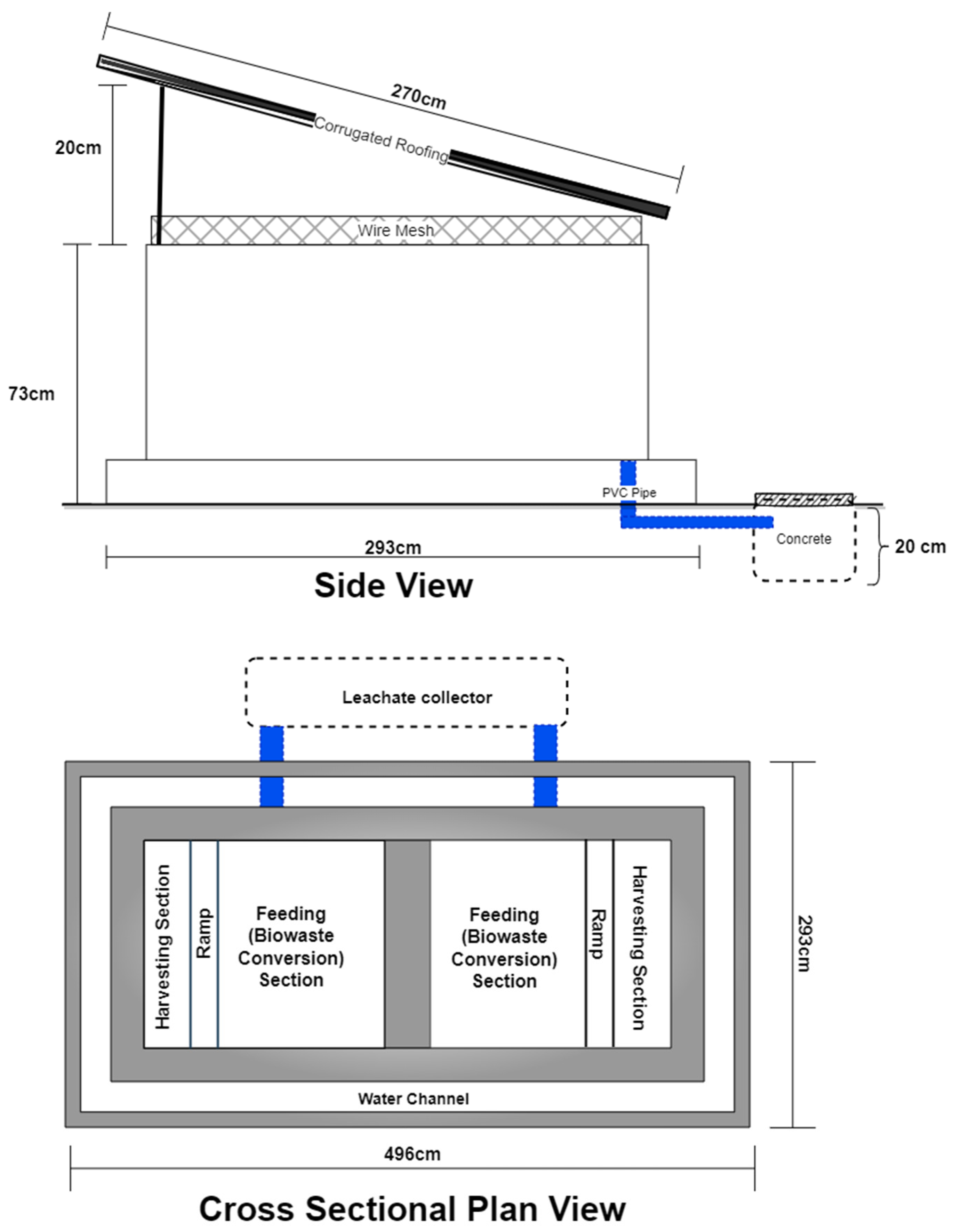
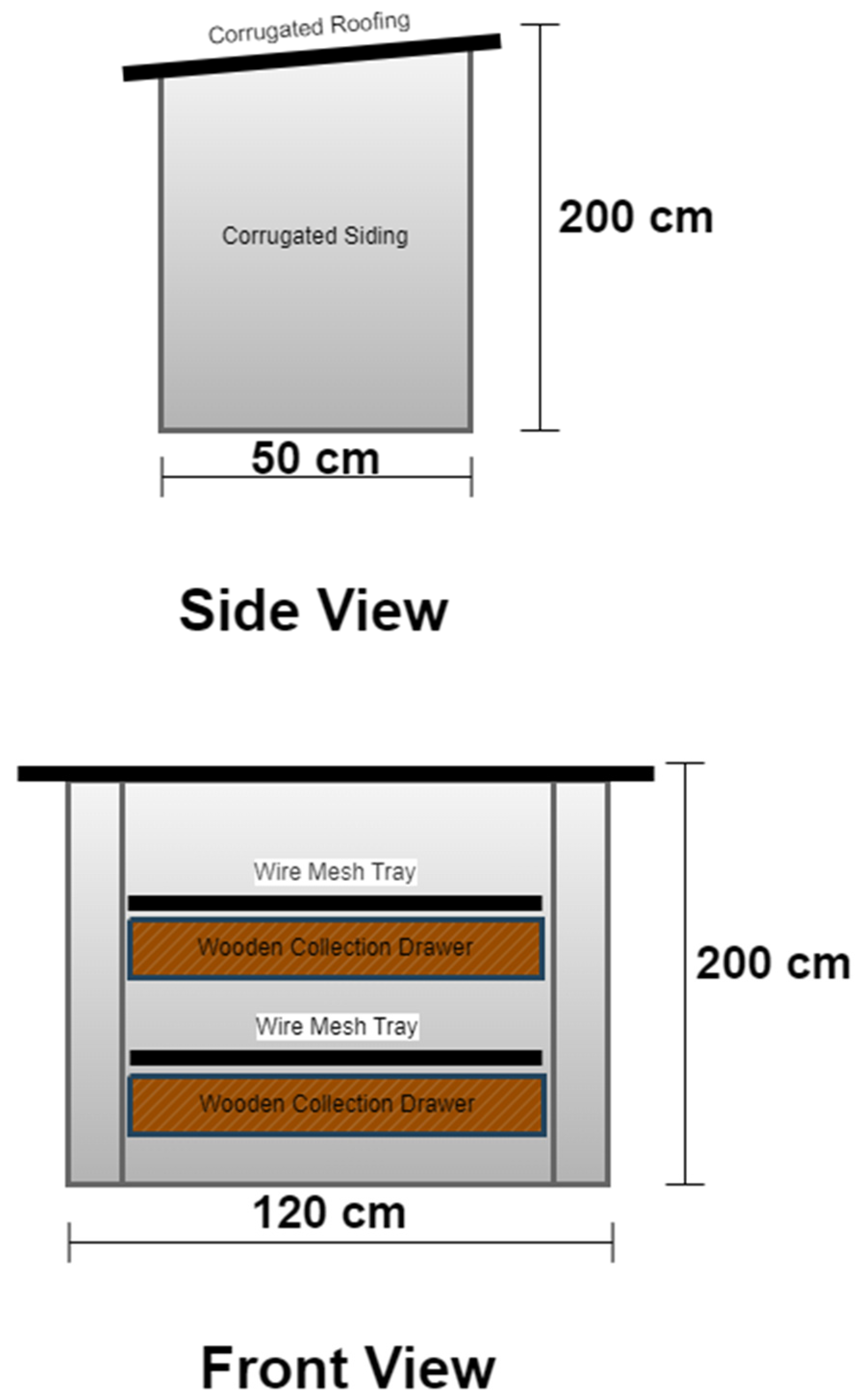
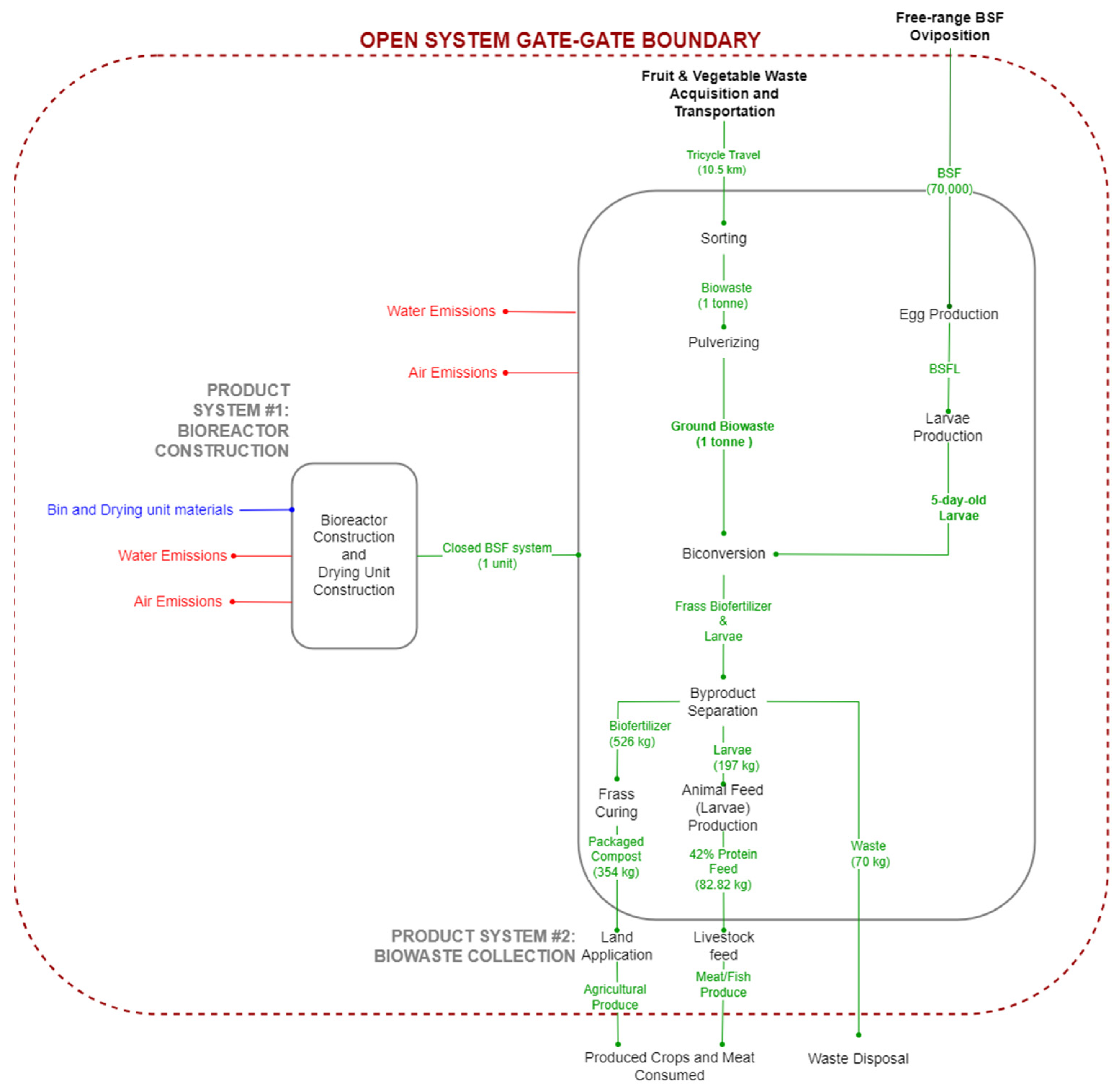


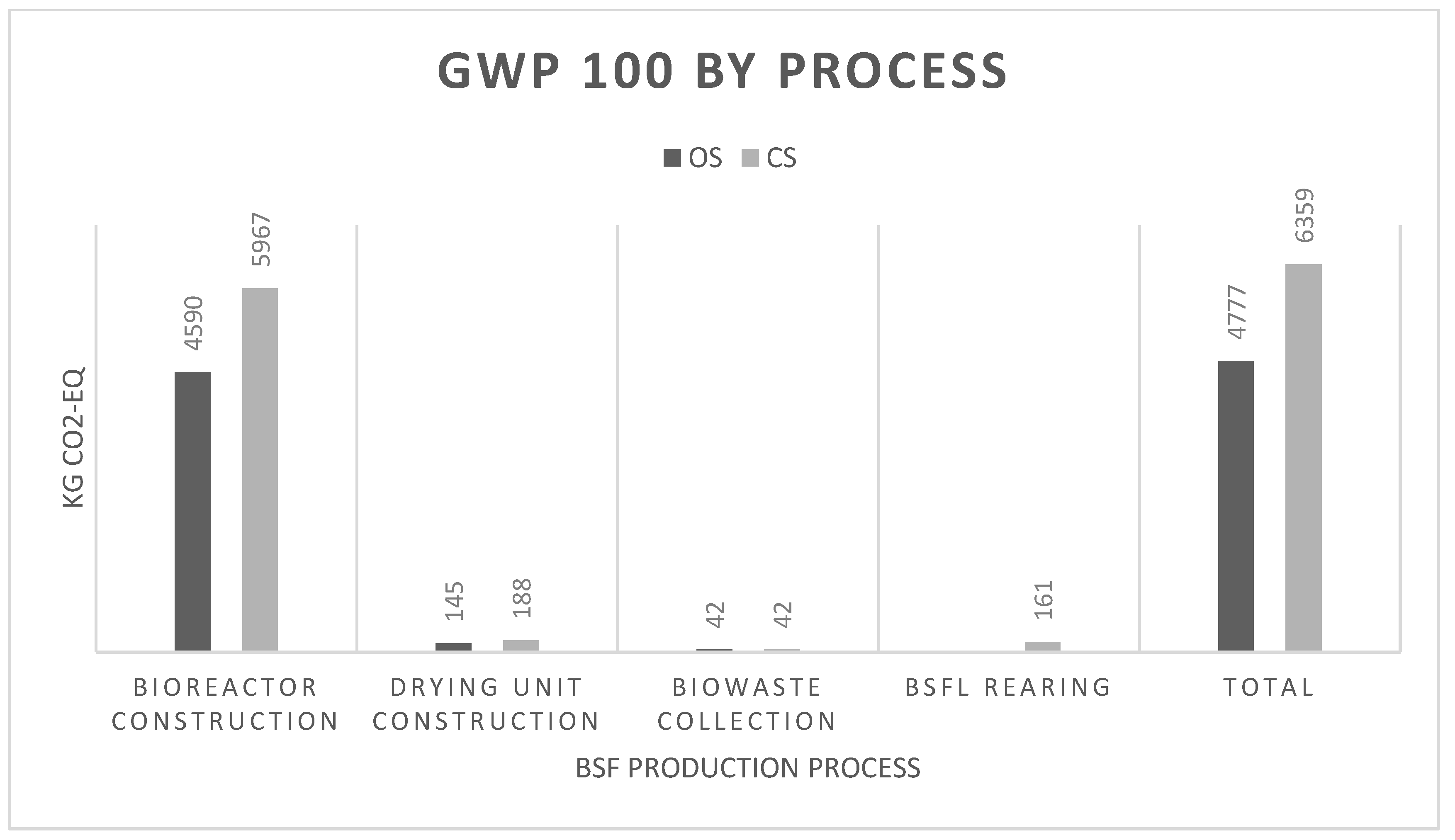
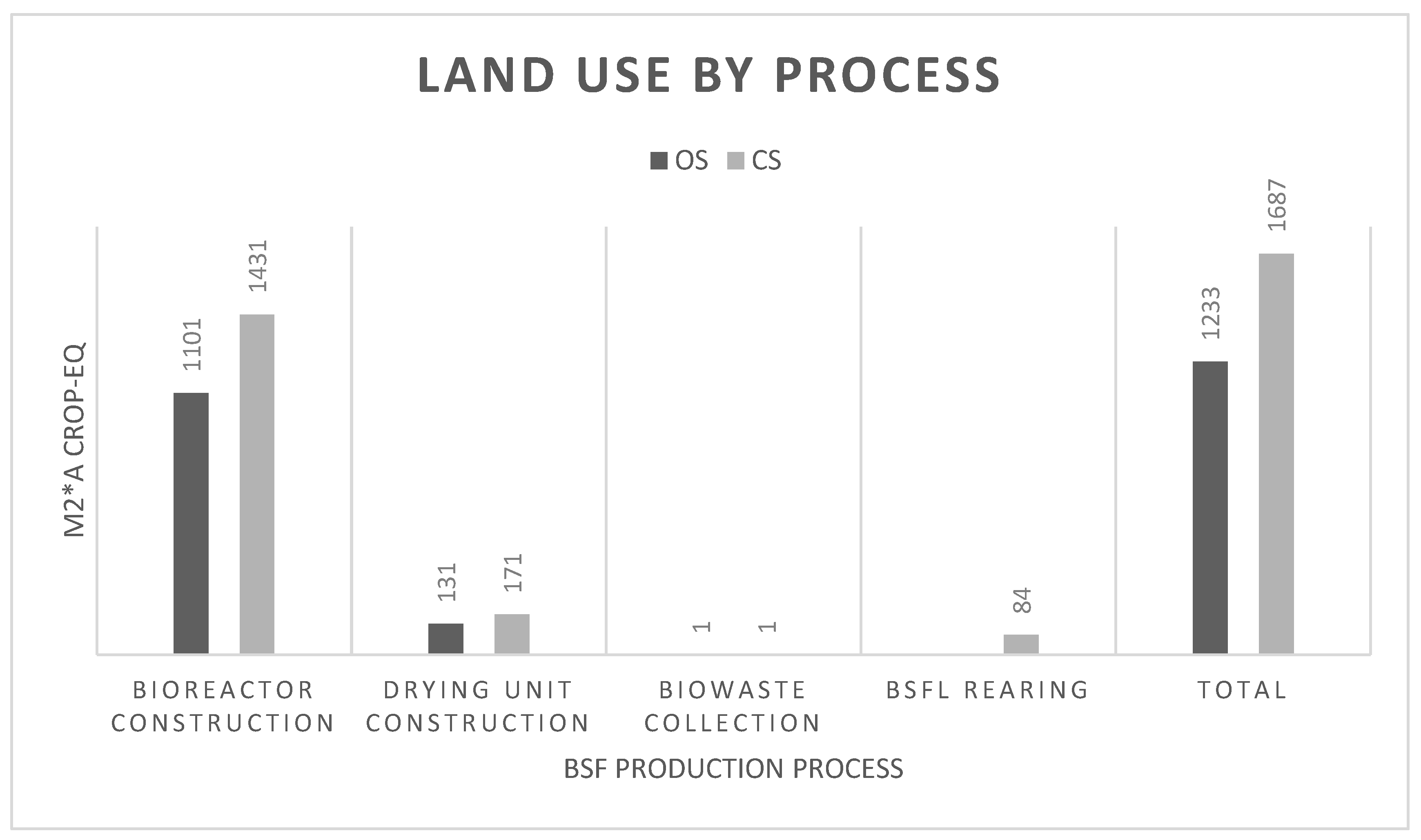


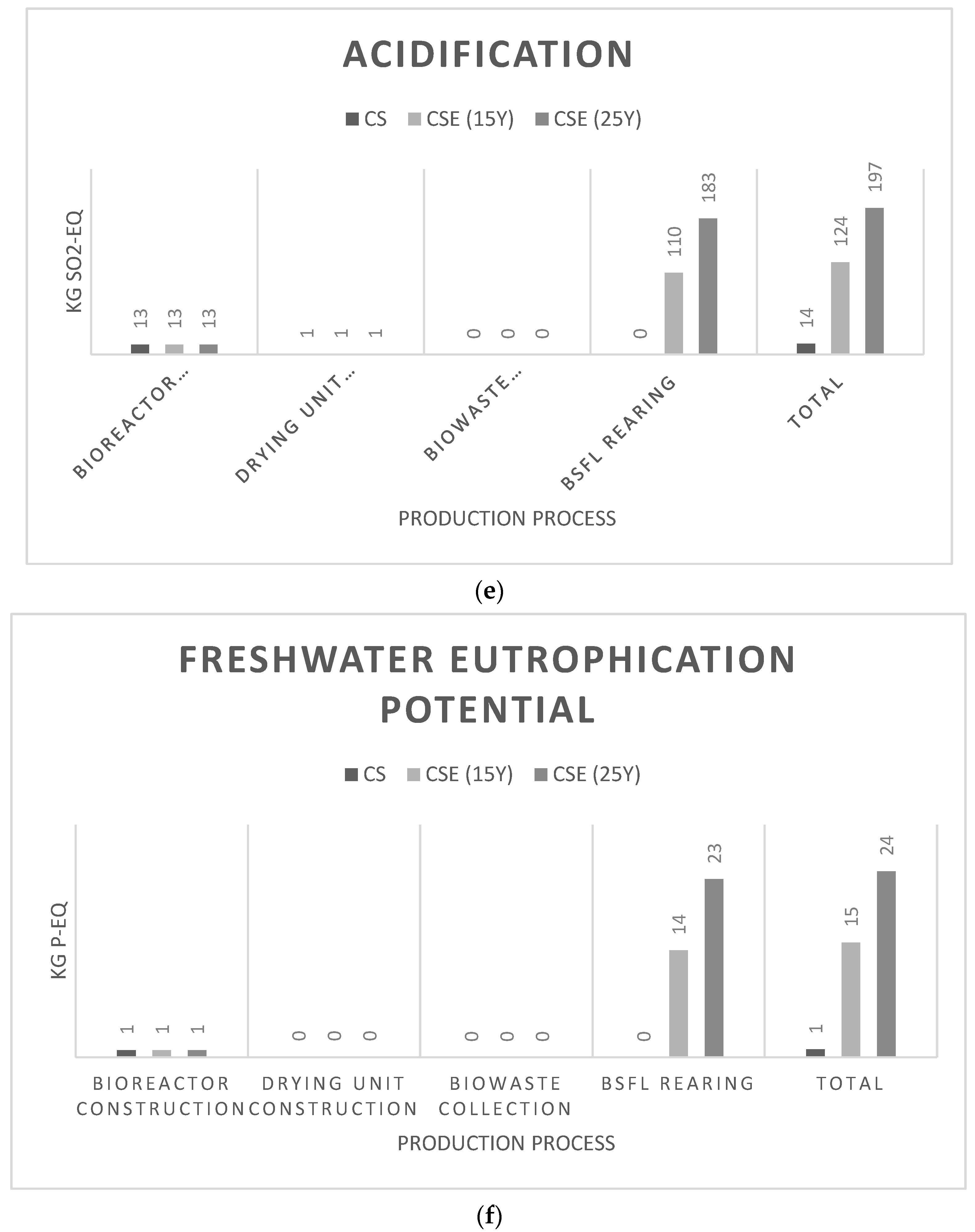

| BSF System | Pros | Cons |
|---|---|---|
| Open | Suitable for farmers with limited time for larval production [8]. | Adaptable for large-scale production [8]. |
| Climate control is not required [5,6]. | BSFL yields vary strongly with seasons because oviposition rates are weather-dependent [8,16]. | |
| Simple designs with comparable procedures [8]. | Required disposal of residue halts production [2,8]. | |
| Facilitates waste treatment in remote and challenging locations [10]. | Applicable only in regions with naturally occurring BSF [2,8]. | |
| Adaptable to the technological and operational requirements and future increased demand of the local context [10]. | High chitin and less digestible migrating prepupae are harvested [8]. | |
| Provides an accessible solution to poor sanitation infrastructure for low- and middle-income countries with favorable weather [11]. | Low-efficiency model that lacks an established or secured market. Meeting increased demand will be challenging [2,10,11]. | |
| BSF do not transmit pathogens and rarely enter dwellings, unlike house flies (Musca domestica) [12,15]. | Lacks quality control and assurance of the products. Hygiene standards are unregulated [10]. | |
| Through colonization, BSF eliminates the presence of house flies [15]. | BSF colonization, although vital for high biomass production, is dependent on natural conditions, which makes it unpredictable [11]. | |
| Self-adjusts larval development duration in response to waste scarcity, thus allowing for the manipulation of larvae population and storage [15]. | Reduced opportunities for administering process improvement interventions [2]. | |
| Closed | The units can be split for efficiency and mutual benefit. Large-scale centralized facilities can produce BSF eggs efficiently and cost-effectively. While small-scale farmers use the hatched eggs in growing the biomass-rich BSFL [8]. | Requires two separate units, one for rearing and another for larvae growth [8]. |
| Increased production facilitates contracts with the animal feed sector and other industries [10]. | Egg rearing is unsuitable for small-scale farmers due to its complexity and time requirement [8]. | |
| High-quality control and hygiene standards [10]. | High energy input required for lighting, mechanization, climate control and automation [7,8,9]. | |
| Emissions and all waste generated can be centrally controlled [10]. | Capital intensive investment [2,10]. | |
| Abiotic conditions like temperature and humidity are easily controlled [9]. | Transportation costs for hauling large waste quantities with minimal adaptability for changes in the waste source [10]. |
| Month | Biowaste (kg) |
|---|---|
| November | 632 |
| December | 616 |
| January | 655 |
| Monthly Average | 634.33 (+/−19.6 STD) |
| Month | BSF Harvest (kg, Wet Weight) | Frass Harvest (kg, Dry Weight) |
|---|---|---|
| December | 3.0 | 8 |
| January | 7.26 | 10 |
| February | 2.25 | 6 |
| Monthly Average | 4.17 | 8 |
| At 1 ton/day biowaste | 197.19 | 378.35 |
| Closed System Process | Parameter | Source |
|---|---|---|
| BSF Rearing | 70,000 flies | [13] |
| 700 g weight of flies | [37] | |
| 2.88 kWh (electricity) | [28] | |
| 3.57 kg compost | [28] | |
| 3.1 kg chicken feed | [28] | |
| BSFL Bioconversion and Harvesting | 2.93 kWh (electricity) | [28] |
| 664 liters of water | [28] |
| Assumption | References |
|---|---|
| Incoming biowaste is manually sorted and grinded, i.e., broken to BSFL digestible sizes. Therefore, water and energy use in the closed system are ignored. | Case study, [28,38] |
| Waste generated post-BSFL bioconversion is left on farmland, is biodegradable and reabsorbed into the soil. | Case study |
| BSFL produced through the OS and CS are equivalent. The production rates remain consistent through different seasons of the year. | |
| Composting in the drying unit is the same for both systems, with impacts equivalent to composting in a composting facility. | ecoinvent 3.91 |
| Mass losses from the input biowaste, particularly in curing the residue, are predominately due water loss to the environment. Climate control was ignored in the CS. Materials required in the installation of windows, doors, and electrical wiring for producing illumination for BSF mating in the CS were also excluded. Energy input required in the construction of the OS was not measured and therefore assumed as equal for both OS and CS, and it was not included in the assessment. | [38] Case study |
| Month | Water Use [m3] | GWP100 [kg CO2-Eq] | FFP [kg oil-Eq] | Land Use [m2·a crop-Eq] | Acidification [kg SO2-Eq] | Eutrophication [kg P-Eq] | ||||||
|---|---|---|---|---|---|---|---|---|---|---|---|---|
| OS | CS | OS | CS | OS | CS | OS | CS | OS | CS | OS | CS | |
| Bioreactor Construction | 24.62 | 32.01 | 4590.16 | 5967.21 | 705.28 | 916.87 | 1100.86 | 1431.12 | 10.37 | 13.49 | 0.70 | 0.92 |
| Drying Unit Construction | 3.83 | 4.97 | 144.76 | 188.18 | 32.33 | 42.03 | 131.28 | 170.66 | 0.40 | 0.52 | 0.07 | 0.09 |
| Biowaste Collection | 0.10 | 0.10 | 42.42 | 42.42 | 12.38 | 12.38 | 0.92 | 0.92 | 0.08 | 0.08 | 0.01 | 0.01 |
| BSFL Rearing | - | 7.17 | - | 160.87 | - | 20.03 | - | 84.30 | - | 0.27 | - | 0.01 |
| Total | 28.55 | 44.26 | 4777.34 | 6358.69 | 749.99 | 991.30 | 1233.06 | 1687.05 | 10.86 | 14.36 | 0.78 | 1.02 |
Disclaimer/Publisher’s Note: The statements, opinions and data contained in all publications are solely those of the individual author(s) and contributor(s) and not of MDPI and/or the editor(s). MDPI and/or the editor(s) disclaim responsibility for any injury to people or property resulting from any ideas, methods, instructions or products referred to in the content. |
© 2023 by the authors. Licensee MDPI, Basel, Switzerland. This article is an open access article distributed under the terms and conditions of the Creative Commons Attribution (CC BY) license (https://creativecommons.org/licenses/by/4.0/).
Share and Cite
Chineme, A.; Assefa, G. Open and Closed Black Soldier Fly Systems Tradeoff Analysis. Sustainability 2023, 15, 16677. https://doi.org/10.3390/su152416677
Chineme A, Assefa G. Open and Closed Black Soldier Fly Systems Tradeoff Analysis. Sustainability. 2023; 15(24):16677. https://doi.org/10.3390/su152416677
Chicago/Turabian StyleChineme, Atinuke, and Getachew Assefa. 2023. "Open and Closed Black Soldier Fly Systems Tradeoff Analysis" Sustainability 15, no. 24: 16677. https://doi.org/10.3390/su152416677





